Abstract
To assess the potential for mycotoxin contamination of the human food supply following the 1988 U.S. drought, 92 grain food samples were purchased from retail outlets in the summer of 1989 and surveyed for aflatoxin B1, zearalenone, and deoxynivalenol (DON [vomitoxin]) by monoclonal antibody-based competitive enzyme-linked immunosorbent assay (ELISA). Only one sample (buckwheat flour) was found to contain aflatoxin B1 (12 ng/g), whereas zearalenone was found in 26% of the samples at a mean concentration of 19 ng/g. In contrast, the DON ELISA was positive in 50% of the samples at a detection level of 1.0 micrograms/g. Between 63 and 88% of corn cereals, wheat flour/muffin mixes, rice cereals, and corn meal/muffin mixes yielded positive results for DON, whereas 25 to 50% of oat cereals, wheat- and oat-based cookies/crackers, corn chips, popcorn, and mixed-grain cereals were positive for DON. The mean DON content of the positive samples was 4.0 micrograms/g, and the minimum and maximum levels were 1.2 and 19 micrograms/g, respectively. When positive ELISA samples were also analyzed by high-performance liquid chromatography, a strong correlation between the two methods was found. The presence of DON in the two highest samples, corn meal and mixed-grain cereal, which contained 19 and 16 micrograms/g, respectively, was quantitatively confirmed by gas chromatography-mass spectrometry. The results indicated that DON was present in 1989 retail food products at concentrations that exceeded those found in previous market surveys and that have been experimentally associated with impaired animal health.
Full text
PDF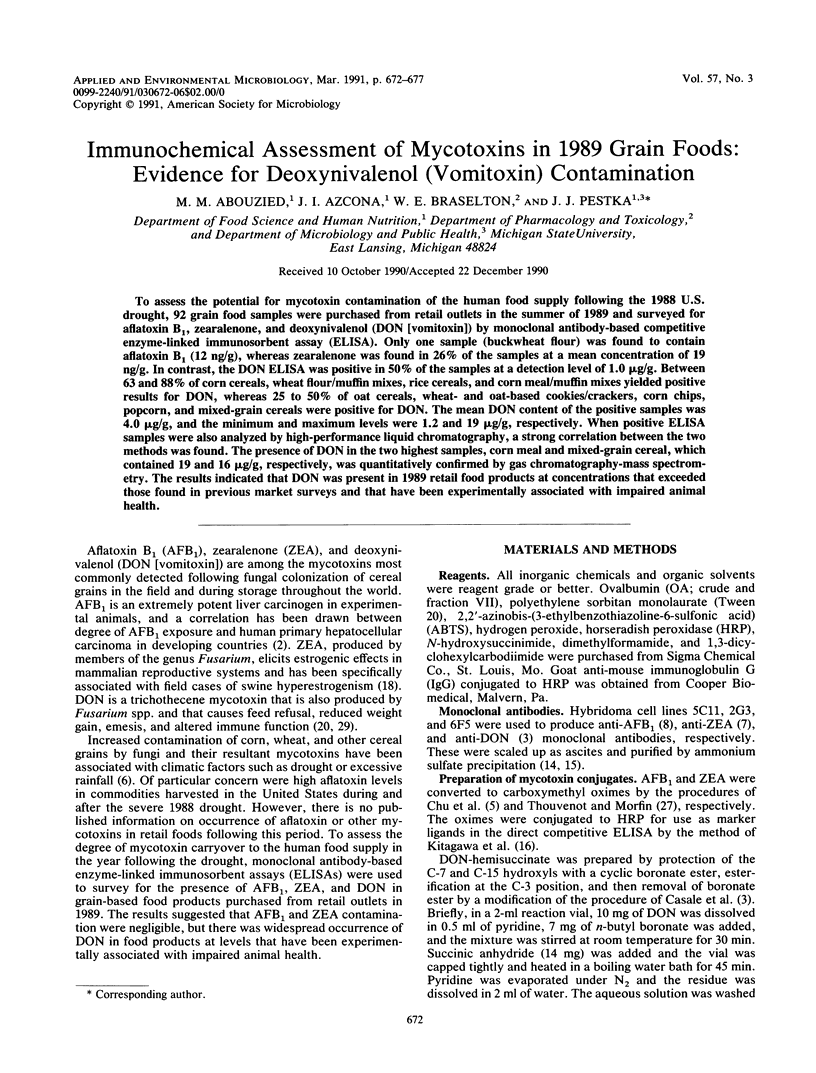
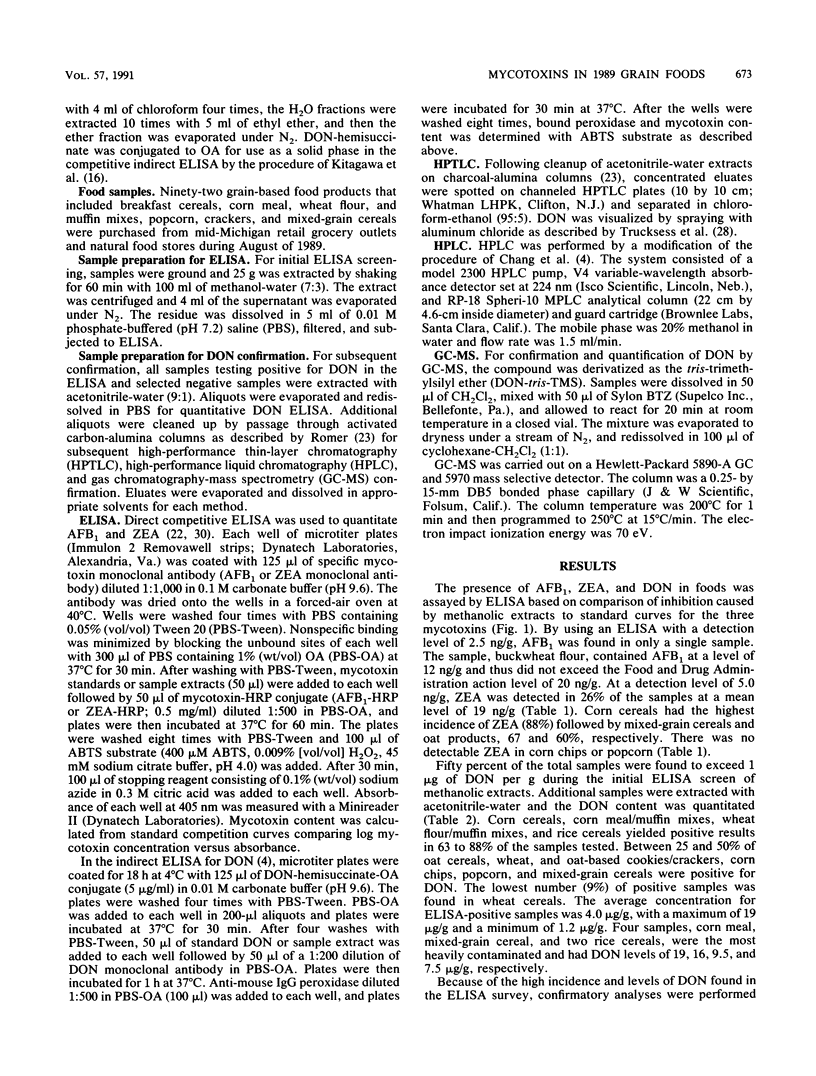
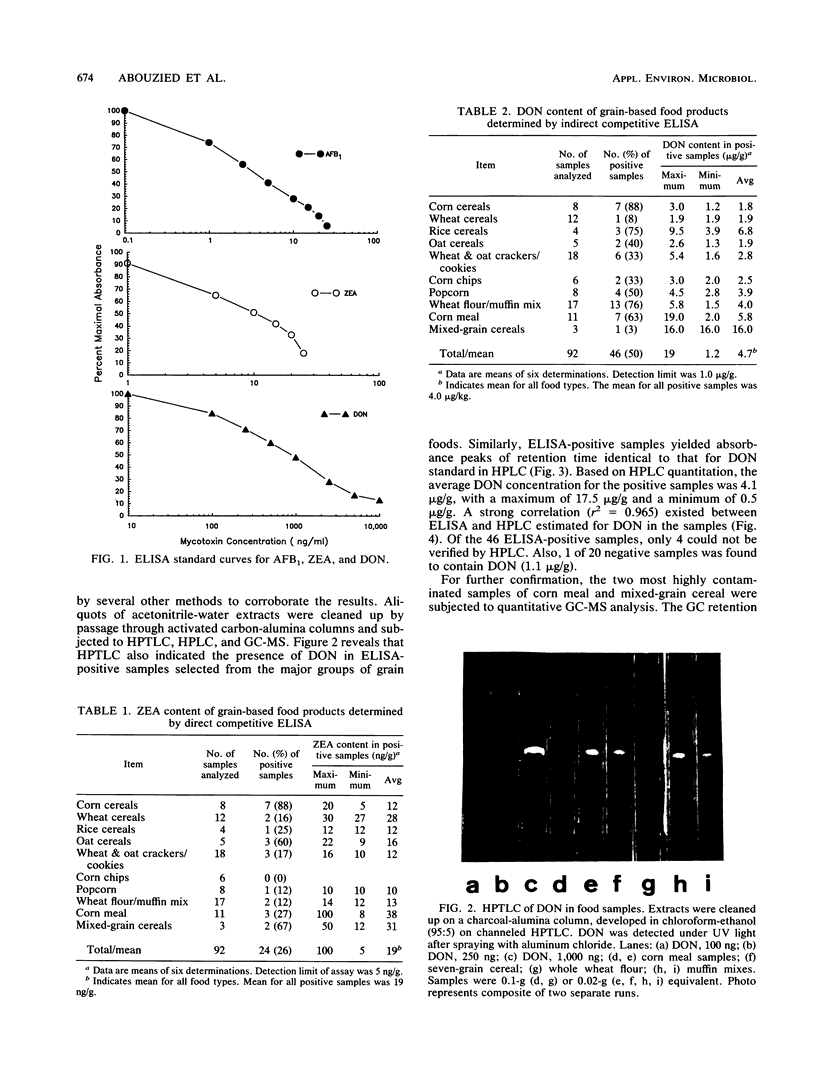
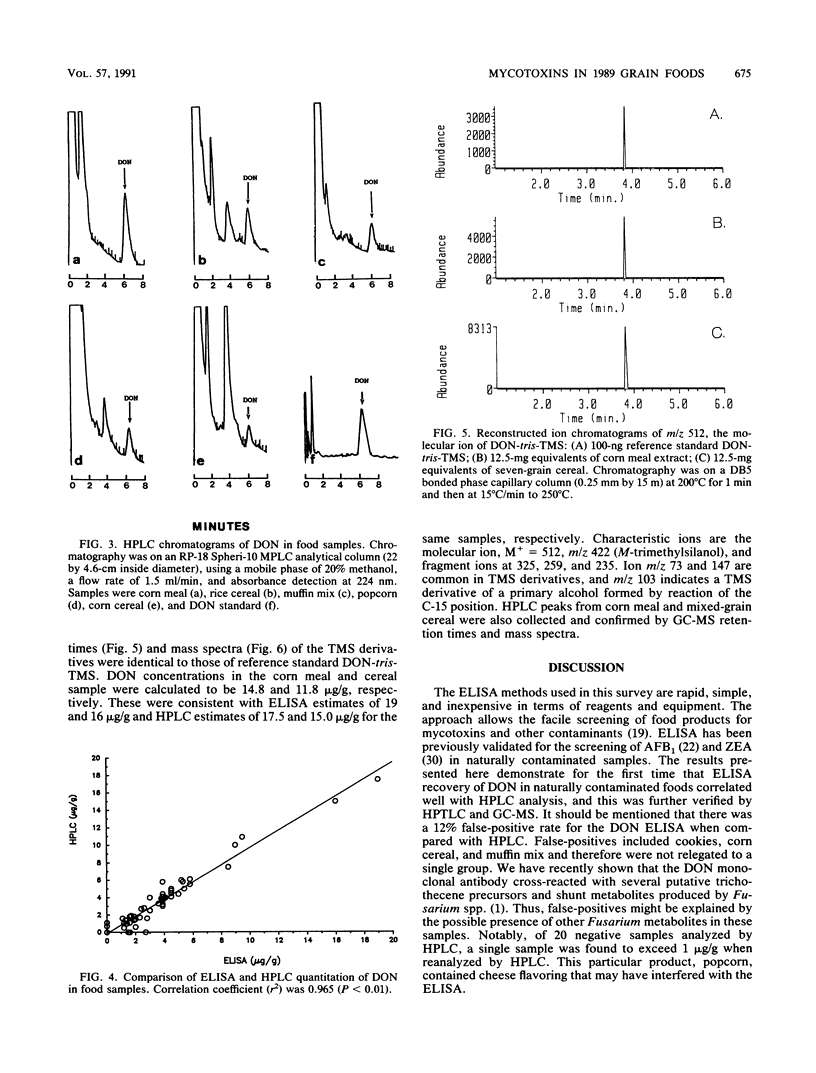
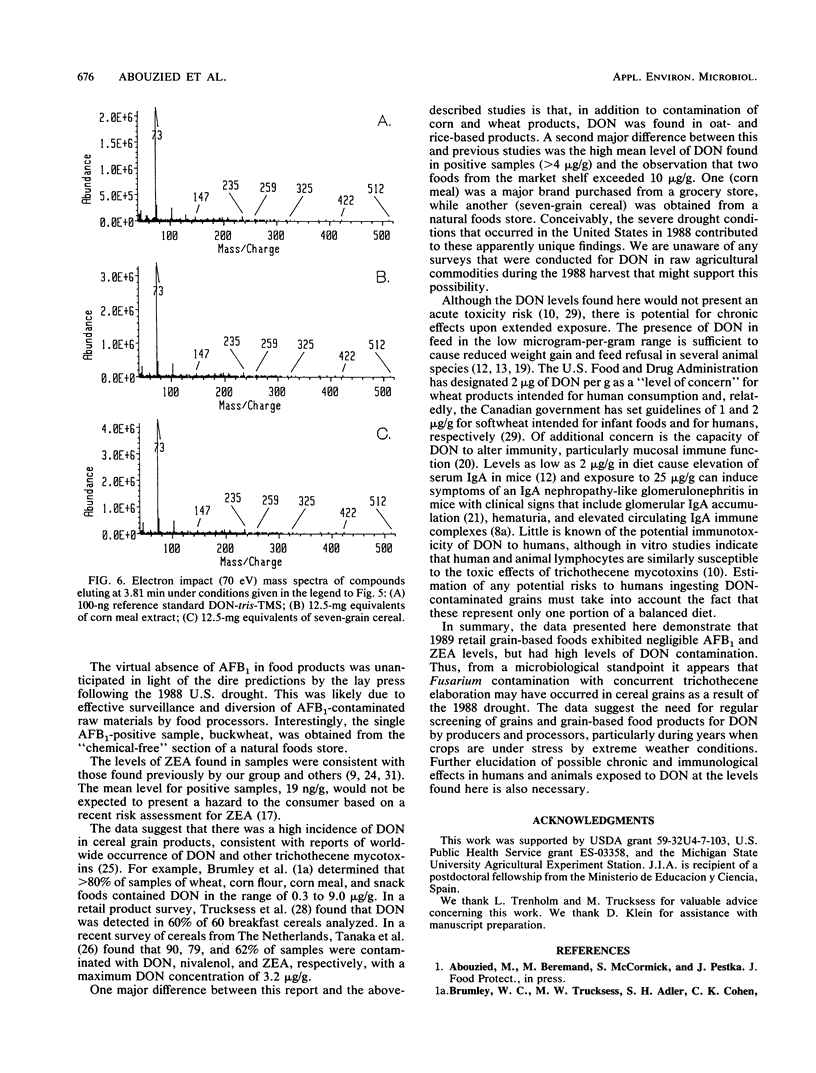
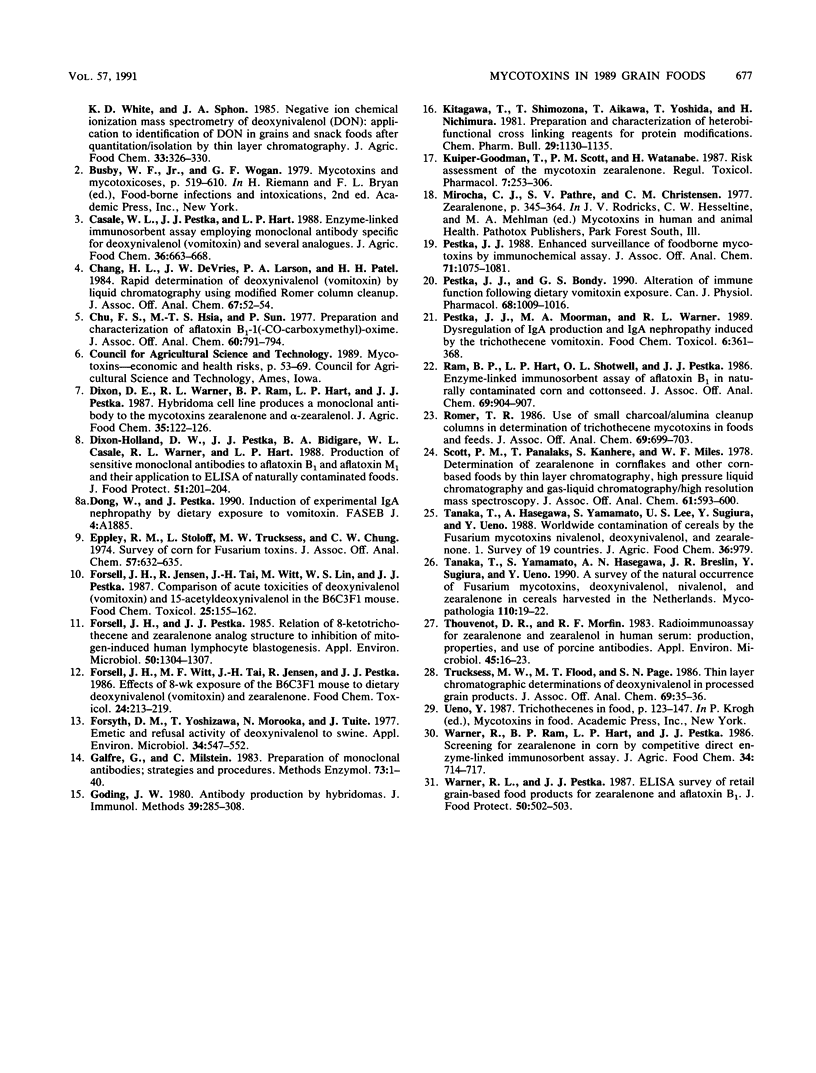
Images in this article
Selected References
These references are in PubMed. This may not be the complete list of references from this article.
- Chang H. L., DeVries J. W., Larson P. A., Patel H. H. Rapid determination of deoxynivalenol (vomitoxin) by liquid chromatography using modified Romer column cleanup. J Assoc Off Anal Chem. 1984 Jan-Feb;67(1):52–54. [PubMed] [Google Scholar]
- Chu F. S., Hsia M. T., Sun P. S. Preparation and characterization of aflatox-n B1-1-(O-carboxymethyl) oxime. J Assoc Off Anal Chem. 1977 Jul;60(4):791–794. [PubMed] [Google Scholar]
- Eppley R. M., Stoloff L., Trucksess M. W., Chung C. W. Survey of corn for Fusarium toxins. J Assoc Off Anal Chem. 1974 May;57(3):632–635. [PubMed] [Google Scholar]
- Forsell J. H., Jensen R., Tai J. H., Witt M., Lin W. S., Pestka J. J. Comparison of acute toxicities of deoxynivalenol (vomitoxin) and 15-acetyldeoxynivalenol in the B6C3F1 mouse. Food Chem Toxicol. 1987 Feb;25(2):155–162. doi: 10.1016/0278-6915(87)90149-9. [DOI] [PubMed] [Google Scholar]
- Forsell J. H., Pestka J. J. Relation of 8-ketotrichothecene and zearalenone analog structure to inhibition of mitogen-induced human lymphocyte blastogenesis. Appl Environ Microbiol. 1985 Nov;50(5):1304–1307. doi: 10.1128/aem.50.5.1304-1307.1985. [DOI] [PMC free article] [PubMed] [Google Scholar]
- Forsell J. H., Witt M. F., Tai J. H., Jensen R., Pestka J. J. Effects of 8-week exposure of the B6C3F1 mouse to dietary deoxynivalenol (vomitoxin) and zearalenone. Food Chem Toxicol. 1986 Mar;24(3):213–219. doi: 10.1016/0278-6915(86)90231-0. [DOI] [PubMed] [Google Scholar]
- Forsyth D. M., Yoshizawa T., Morooka N., Tuite J. Emetic and refusal activity of deoxynivalenol to swine. Appl Environ Microbiol. 1977 Nov;34(5):547–552. doi: 10.1128/aem.34.5.547-552.1977. [DOI] [PMC free article] [PubMed] [Google Scholar]
- Goding J. W. Antibody production by hybridomas. J Immunol Methods. 1980;39(4):285–308. doi: 10.1016/0022-1759(80)90230-6. [DOI] [PubMed] [Google Scholar]
- Houghton P. J., Tharp R., Houghton J. A., Holland J. F., Bekesi J. G. Evaluation of 3-(p-fluorophenyl)-L-alanyl-3-[m-bis-(2-chloroethyl) aminophenyl]-L-alanyl-L-methionine ethyl ester HCl (PTT.119) against xenografts of human rhabdomyosarcoma. Cancer Chemother Pharmacol. 1988;22(3):201–204. doi: 10.1007/BF00273411. [DOI] [PubMed] [Google Scholar]
- Kuiper-Goodman T., Scott P. M., Watanabe H. Risk assessment of the mycotoxin zearalenone. Regul Toxicol Pharmacol. 1987 Sep;7(3):253–306. doi: 10.1016/0273-2300(87)90037-7. [DOI] [PubMed] [Google Scholar]
- Pestka J. J., Bondy G. S. Alteration of immune function following dietary mycotoxin exposure. Can J Physiol Pharmacol. 1990 Jul;68(7):1009–1016. doi: 10.1139/y90-154. [DOI] [PubMed] [Google Scholar]
- Pestka J. J. Enhanced surveillance of foodborne mycotoxins by immunochemical assay. J Assoc Off Anal Chem. 1988 Nov-Dec;71(6):1075–1081. [PubMed] [Google Scholar]
- Pestka J. J., Moorman M. A., Warner R. L. Dysregulation of IgA production and IgA nephropathy induced by the trichothecene vomitoxin. Food Chem Toxicol. 1989 Jun;27(6):361–368. doi: 10.1016/0278-6915(89)90141-5. [DOI] [PubMed] [Google Scholar]
- Ram B. P., Hart L. P., Shotwell O. L., Pestka J. J. Enzyme-linked immunosorbent assay of aflatoxin B1 in naturally contaminated corn and cottonseed. J Assoc Off Anal Chem. 1986 Sep-Oct;69(5):904–907. [PubMed] [Google Scholar]
- Romer T. R. Use of small charcoal/alumina cleanup columns in determination of trichothecene mycotoxins in foods and feeds. J Assoc Off Anal Chem. 1986 Jul-Aug;69(4):699–703. [PubMed] [Google Scholar]
- Scott P. M., Panalaks T., Kanhere S., Miles W. F. Determination of zearalenone in cornflakes and other corn-based foods by thin layer chromatography, high pressure liquid chromatography, and gas-liquid chromatography/high resolution mass spectrometry. J Assoc Off Anal Chem. 1978 May;61(3):593–600. [PubMed] [Google Scholar]
- Tanaka T., Yamamoto S., Hasegawa A., Aoki N., Besling J. R., Sugiura Y., Ueno Y. A survey of the natural occurrence of Fusarium mycotoxins, deoxynivalenol, nivalenol and zearalenone, in cereals harvested in the Netherlands. Mycopathologia. 1990 Apr;110(1):19–22. doi: 10.1007/BF00442765. [DOI] [PubMed] [Google Scholar]
- Thouvenot D., Morfin R. F. Radioimmunoassay for zearalenone and zearalanol in human serum: production, properties, and use of porcine antibodies. Appl Environ Microbiol. 1983 Jan;45(1):16–23. doi: 10.1128/aem.45.1.16-23.1983. [DOI] [PMC free article] [PubMed] [Google Scholar]
- Trucksess M. W., Flood M. T., Page S. W. Thin layer chromatographic determination of deoxynivalenol in processed grain products. J Assoc Off Anal Chem. 1986 Jan-Feb;69(1):35–36. [PubMed] [Google Scholar]



